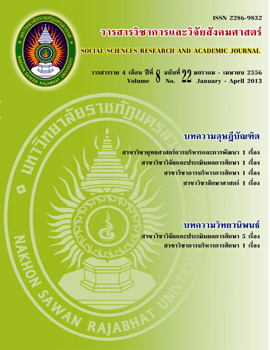การพัฒนาแผนการจัดการศึกษาเฉพาะบุคคล (IEP) สำหรับนักเรียน ที่มีความบกพร่องทางการเรียนรู้ (LD) ระดับชั้นประถมศึกษา
Main Article Content
Abstract
บทคัดย่อ
การวิจัยครั้งนี้มีวัตถุประสงค์เพื่อพัฒนาแผนการจัดการศึกษาเฉพาะบุคคล (IEP) สำหรับนักเรียนที่มีความบกพร่องทางการเรียนรู้ (LD) ระดับชั้นประถมศึกษา การวิจัยแบ่งเป็น 3 ขั้นตอนคือ ขั้นที่ 1 ศึกษาสภาพ และปัญหาความบกพร่องของนักเรียน ผู้วิจัยดำเนินการเก็บรวบรวมข้อมูลจากครูประจำชั้นและผู้ปกครองของนักเรียนที่มีความบกพร่องทางการเรียนรู้โดยวิธีการสัมภาษณ์ พร้อมทั้งการสังเกตของผู้วิจัย มีการตรวจสอบเอกสารและสมุดแบบฝึกหัดของนักเรียน และครูประจำชั้นร่วมกับผู้วิจัยทำการคัดกรองนักเรียนอีกครั้ง ขั้นที่ 2 สร้างและตรวจสอบคุณภาพของแผนการจัดการศึกษาเฉพาะบุคคล (IEP) ผู้ให้ข้อมูลเป็นผู้เชี่ยวชาญจำนวน 5 ท่าน ขั้นที่ 3 การใช้แผนการจัดการศึกษาเฉพาะบุคคล (IEP) ที่ผู้วิจัยสร้างขึ้นนำไปใช้กับนักเรียนที่มีความบกพร่องทางการเรียนรู้ (LD) ชั้นประถมศึกษาปีที่ 1 โรงเรียนวัดคลองสองหน่อ ผู้วิจัยสังเกตพัฒนาการทางการเรียน และเปรียบเทียบผลสัมฤทธิ์ทางการเรียนของนักเรียนระหว่างก่อนและหลังเรียน วิเคราะห์ข้อมูลโดยการวิเคราะห์เนื้อหาตามประเด็นที่ศึกษา และนำเสนอเชิงพรรณนา
ผลการวิจัยพบว่า
1. นักเรียนที่มีความบกพร่องทางการเรียนรู้จะเรียนช้าในรายวิชาคณิตศาสตร์ เนื่องจากมีปัญหาเรื่องการนับจำนวน เขียนตัวเลขแทนจำนวนไม่ได้ และยังมีปัญหาเรื่องการบวกและการลบร่วมด้วย
2. แผนการจัดการศึกษาเฉพาะบุคคล (IEP) สำหรับนักเรียนที่มีความบกพร่องทางการเรียนรู้ (LD) ระดับชั้นประถมศึกษา มีความเหมาะสมกับความต้องการของนักเรียน ซึ่งผลการตรวจสอบคุณภาพด้านความสอดคล้องขององค์ประกอบ พบว่า ดัชนีความสอดคล้องขององค์ประกอบของแผนการจัดการศึกษาเฉพาะบุคคล (IEP) มีความสอดคล้องทุกข้อ และผลการตรวจสอบคุณภาพด้านความเหมาะสมขององค์ประกอบ พบว่า องค์ประกอบของแผนการจัดการศึกษาเฉพาะบุคคล (IEP) โดยรวมอยู่ในระดับมาก
3. นักเรียนให้ความสนใจกับการเรียนมากขึ้นทั้งขณะอยู่ที่บ้านและที่โรงเรียน นักเรียนเกิดความสนใจ ตั้งใจฟัง ตั้งใจปฏิบัติกิจกรรมโดยที่ครูไม่ต้องเตือน กล้าแสดงออก และมีความกระตือรือร้นมากขึ้น ทำให้นักเรียนสามารถนับจำนวน บวกเลข ลบเลข และเขียนตัวเลข นอกจากนี้นักเรียนยังมีผลสัมฤทธิ์ทางการเรียนหลังเรียนสูงกว่าก่อนเรียน เมื่อพิจารณาคะแนนพัฒนาการ พบว่ามีพัฒนาการเพิ่มขึ้นร้อยละ 73.33
Abstract
The purposes of this research were to develop an individualized education program for students with learning disabilities for primary level. This research was separated into 3 steps. Step 1 studying the state and problem of learning disabilities. Data collection was from teachers and parents of students with learning disabilities by interview and observation of the researcher, investigation of the documents and student’ workbook, and student screening by teachers with researcher again. Step 2, establishing and quality monitoring of the development of individualized education program . The contributors are 5 experts who are experts in this research. Step 3, using the individualized education program (IEP) that the researcher designed with the students with learning disabilities in primary level 1, Wat-Klong-Song-Nor school. The researcher observed the development of learning and compared the learning achievement of the students between before and after learning. Data analysis was by content analysis and presented in descriptive statistics.
The findings were as follows:
1. The students with learning disabilities the learn slowly in mathematics because of counting problem, not being able to write the numbers, and positive-negative problems.
2. The researcher establishes the individualized education program for students with learning disabilities for primary level as suitable with the requirement of the students. With regard to investigation of quality in the corresponding element of the individualized education program when considering each item, the findings showed the index of corresponding in all items. And the result of investigation of quality in suitable element suggesed that experts’ opinions on suitable element of the individualized of education program by overall were at a high level.
3. The students’ interest in learning increased both at home and at school. The students because interested, listened intentionally, performed activities intentionally without warning from teachers, daned to show and were more enthusiastic, could count, add, subframe and write numbers. In addition, they have the learning achievement after learning higher than before learning. When considering the development of the score, the findings suggest that the development increased to 73.33%.


